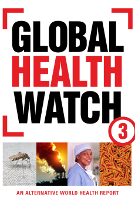4.06 Global immunization vision and strategy
From the Secretariat's annotation of the EB Agenda
Resolution WHA61.15 requests the Director-General to report on progress made towards achievement of global immunization goals. The report describes the implementation of the Global Immunization Vision and Strategy 2006-2015 and gives an outline of efforts made by WHO, UNICEF, the Bill & Melinda Gates Foundation and other stakeholders to launch a 2011–2020 Decade of Vaccines and Immunization. The Board is invited to consider endorsement of the new initiative’s process and scope.
PHM Comment (from PHM letter to EB members)
A ‘one-size-fits-all’ approach in the introduction of new vaccines should be avoided. National priorities are not everywhere the same. The introduction of new vaccines should be subject to detailed needs assessment studies, cost-benefit analyses and public health impact assessments which recognize the specific circumstances of each member state. WHO should assist member states in undertaking such studies where appropriate. An urgent focus is required on adequately strengthening the vaccine delivery system without disrupting existing health services.
It is recognized that effective and efficient vaccine delivery requires and should be mediated through well functioning health systems. It is less widely recognized that a pre-occupation with immunisation delivery can disrupt health care delivery with serious negative consequences.
Sustainability is a key criterion in the financing of immunization programs. While Global Alliance on Vaccines and Immunizations (GAVI) may subsidize the cost of new vaccines for a few years, the capacity of member states to carry those costs in the longer term once the new vaccines have become part of their routine national health strategy needs to be considered. The projected costs of a full course of vaccination (para 25) underlines the importance of affordability.
Member states should be given technical assistance with respect to using the flexibilities provided under the Trade Related aspects of Intellectual Property Rights (TRIPS) Agreement to ensure affordability of vaccines.
The strategy should prioritise the provision of technical support and technology transfer to strengthen the capacity of member states to produce vaccines domestically. We recommend a focus on building research and manufacturing capacity in the public sector so governments are not over-reliant on the private vaccine industry and biotech industry.
The strategy mentions monitoring and surveillance of immunization but should also include reference to the monitoring of adverse events in the use of vaccines. Likewise the strategy should include the promotion of safe injection, proper storage of vaccines and ensuring appropriate compensation mechanisms for adverse events.
Background Documentation
In a report released in 2010 , Médecins Sans Frontières (MSF) and Oxfam International warn that the global approach to ensure access to life-saving vaccines for children in the poorest countries is hampered by high prices and is now facing an acute funding crisis.
The report, entitled "Giving Developing Countries the Best Shot", shows how because of the fundamental nature of the vaccine market, it still takes years for expensive new vaccines developed for wealthy countries to reach children across the developing world, and that products emerging from the research pipeline are often insufficiently adapted to developing country needs and conditions.
The Global Alliance for Vaccines and Immunization (GAVI), which leads international efforts to boost immunisation rates in developing countries, has reported considerable success in expanding access to vaccines against Hib and Hepatitis B, two diseases that cause considerable mortality. But the organisation is now facing an acute cash crisis due to high prices for new vaccines and stagnating donor resources. Without an additional US$2.4 billion in donor contributions, GAVI will have to make significant cut-backs that will reduce access to vaccines in poor countries.
GAVI’s attempts to speed up the introduction of pneumococcal conjugate vaccines (PCV) are an illustration of the hurdles faced by the organisation. Used for a number of years in wealthy countries, PCV have prevented hundreds of thousands of cases of pneumonia, meningitis and other serious infections. They have also generated billions of dollars in revenue for multinational drug companies. But the joint efforts of GAVI and donor countries to improve uptake of these blockbuster products in resource-poor settings have stumbled.
Despite repeated announcements heralding the impending roll-out of PCV across developing countries, PCV will remain out of reach for most children due to problems with supply and a lack of funds. Kenya is the only GAVI-eligible country that will receive the newer version of this life-saving vaccine in 2010 and the cost will be US$21 per child. This is an unacceptably high price for donors and developing countries to bear.
MSF and Oxfam are calling for changing the current system so that donor funds incentivise the development of adapted vaccines and ensure affordable prices.
In addition to these reforms, routine immunisation needs to be strengthened. In developing countries, two million children die every year because of the failure to vaccinate with existing vaccines.




